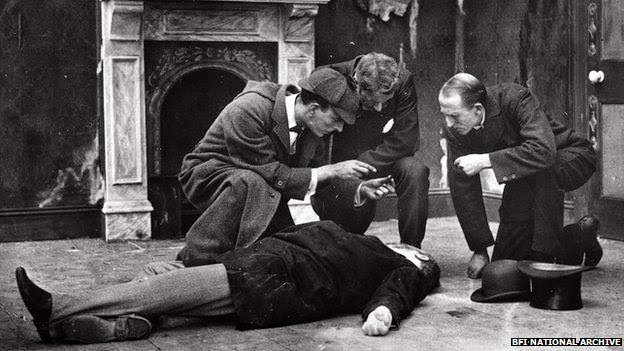Probably not. There is no actual case really, is there?
Should it be in the Canon of Sherlock Holmes?
For sure!
Once again it is the treats we get in the first few paragraphs that make this story fun.
"When one considers that Mr. Sherlock Holmes was in active practice for
twenty-three years, and that during seventeen of these I was allowed to cooperate with him and to keep notes of his doings, it will
be clear that I have a mass of material at my command. The problem has always been not to find
but to choose. There is the long row of year-books
which fill a shelf, and there are the dispatch-cases
filled with documents, a perfect quarry for the student not only of crime but of the social and official
scandals of the late Victorian era. Concerning these
latter, I may say that the writers of agonized letters,
who beg that the honour of their families or the
reputation of famous forebears may not be touched,
have nothing to fear. The discretion and high sense
of professional honour which have always distinguished my friend are still at work in the choice of
these memoirs, and no confidence will be abused.
I deprecate, however, in the strongest way the attempts which have been made lately to get at and
to destroy these papers. The source of these outrages is known, and if they are repeated I have
Mr. Holmes’s authority for saying that the whole
story concerning the politician, the lighthouse, and
the trained cormorant will be given to the public.
There is at least one reader who will understand. "
Just the first sentence is enough to send any Sherlockian into Canonical ecstasy;
"When one considers that Mr. Sherlock Holmes was in active practice for twenty-three years, and that during seventeen of these I was allowed to cooperate with him and to keep notes of his doings, it will be clear that I have a mass of material at my command."
Just the first sentence is enough to send any Sherlockian into Canonical ecstasy;
"When one considers that Mr. Sherlock Holmes was in active practice for twenty-three years, and that during seventeen of these I was allowed to cooperate with him and to keep notes of his doings, it will be clear that I have a mass of material at my command."
Just from this one sentence we learn that Holmes had done well enough at his chosen profession to be able to afford early retirement, sometime before the age of 60. (That is if we agree his birth year was around 1854.)
We learn that Watson was with him for much of this time for he states that he was allowed to cooperate with him for seventeen. (How can that be when they met in 1881 and had a case together in 1914? More like twenty-two years.)
We learn that there are many more that we will never hear about, and that some of these are still rather sensitive to certain individuals.
We often read (in pastiche form) of individuals finding a 'battered tin dispatch box' and recovering lost works of Watson's. In this introductory paragraph we learn that there were indeed "dispatch-cases", plural, containing his writings.
We hear of the famous "trained cormorant" and the "politician" and "the lighthouse".
But for me the most interesting aspect for my imagination is wondering where Watson is at when he puts this story down on paper and how old he is?
It was published in 1927. Watson and Holmes would have probably been in there seventies and both retired.
Is Watson alone, or is he still married" Where is he living? How long has it been since he last met up with Holmes.
It was published in 1927. Watson and Holmes would have probably been in there seventies and both retired.
Is Watson alone, or is he still married" Where is he living? How long has it been since he last met up with Holmes.
Is he in a large estate, earned by his writings and practice? Our is he in a flat in London, or a home for retired service men? Is wife, number what-ever, still alive?
What kind of desk is he seated at?
What kind of desk is he seated at?



.jpg)
















